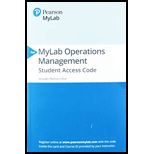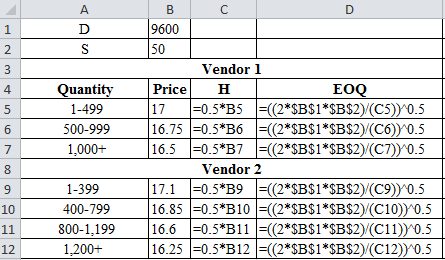
Concept explainers
a)
To determine: The Economic order quantity.
Introduction: Inventory management is the process of ordering, storing and using inventory of the company such raw material, components and finished goods. It governs the flow of goods from manufacturers to warehouse and to the point of sale. The key function is to maintain record of flow of new or returned products which enters or leaves the company.
a)
Answer to Problem 28P
The economic order quantity for vendor A is 336.07 units and for vendor B is 335.08 units.
Explanation of Solution
Given information:
| Vendor 1 | |
| Quantity | Price |
| 1-499 | $17.00 |
| 500-999 | $16.75 |
| 1,000+ | $16.50 |
| Vendor 2 | |
| 1-399 | $17.10 |
| 400-799 | $16.85 |
| 800-1,199 | $16.60 |
| 1,200+ | $16.25 |
Formula:
Where
Calculation of Economic order quantity:
For vendor 1 with quantity 1-499:
EOQ is calculated by multiplying 2, 9600 and 50 and dividing the resultant
Same calculation procedure follows for the rest of the quantities and the result is,
| D | 9600 | ||
| S | $50.00 | ||
| Vendor 1 | |||
| Quantity | Price | H | EOQ |
| 1-499 | $17.00 | $8.50 | 336.07 |
| 500-999 | $16.75 | $8.38 | 338.57 |
| 1,000+ | $16.50 | $8.25 | 341.12 |
| Vendor 2 | |||
| 1-399 | $17.10 | $8.55 | 335.08 |
| 400-799 | $16.85 | $8.43 | 337.56 |
| 800-1,199 | $16.60 | $8.30 | 340.09 |
| 1,200+ | $16.25 | $8.13 | 343.74 |
Working:

Based on the above calculation, the EOQ for vendor A is 336.07 units and for vendor B is 335.08 units.
Hence, the economic order quantity for vendor A is 336.07 units and for vendor B is 335.08 units.
b)
To determine: The quantities to be ordered and supplier to be selected.
b)
Answer to Problem 28P
Vendor 2 should be selected at 1,200 units of ordering quantities
Explanation of Solution
Given information:
| Vendor 1 | |
| Quantity | Price |
| 1-499 | $17.00 |
| 500-999 | $16.75 |
| 1,000+ | $16.50 |
| Vendor 2 | |
| 1-399 | $17.10 |
| 400-799 | $16.85 |
| 800-1,199 | $16.60 |
| 1,200+ | $16.25 |
Formula:
Calculation of ordering quantities:
| D | 9600 | ||||||
| S | $50.00 | ||||||
| Vendor 1 | |||||||
| Quantity | Price | H | EOQ | Holding cost | Ordering cost | Purchase cost | Total cost |
| 336 | $17.00 | $8.50 | 336.07 | $1,428.00 | $1428.6 | $163,200.00 | $166056.57 |
| 500 | $16.75 | $8.38 | 338.57 | $2,093.75 | $960.0 | $160,800.00 | $163853.75 |
| 1000 | $16.50 | $8.25 | 341.12 | $4,125.00 | $480.0 | $158,400.00 | $163005.00 |
| Vendor 2 | |||||||
| 335 | $17.10 | $8.55 | 335.08 | $1,432.13 | $1432.8 | $164,160.00 | $167024.96 |
| 400 | $16.85 | $8.43 | 337.56 | $1,685.00 | $1200.0 | $161,760.00 | $164645.00 |
| 800 | $16.60 | $8.30 | 340.09 | $3,320.00 | $600.0 | $159,360.00 | $163280.00 |
| 1200 | $16.25 | $8.13 | 343.74 | $4,875.00 | $400.0 | $156,000.00 | $161275.00 |
Table 1
Working:

Based on the above calculations it can be inferred that Vendor 2 can be selected because the total cost is least at 1,200 ordering quantities (refer table1).
Hence, vendor 2 should be selected at 1,200 units of ordering quantities.
c)
To determine: The total cost for most economic order quantities.
c)
Answer to Problem 28P
The optimum ordering quantity is 1200 units and total annual cost is $161275.00.
Explanation of Solution
Given information:
| Vendor 1 | |
| Quantity | Price |
| 1-499 | $17.00 |
| 500-999 | $16.75 |
| 1,000+ | $16.50 |
| Vendor 2 | |
| 1-399 | $17.10 |
| 400-799 | $16.85 |
| 800-1,199 | $16.60 |
| 1,200+ | $16.25 |
Calculation of total cost:
Table 1 provides the calculation for total cost.
Hence, the optimum ordering quantity is 1200 units and total annual cost is $161275.00.
d)
To determine: The factors to be considered besides total cost.
d)
Explanation of Solution
Given information:
| Vendor 1 | |
| Quantity | Price |
| 1-499 | $17.00 |
| 500-999 | $16.75 |
| 1,000+ | $16.50 |
| Vendor 2 | |
| 1-399 | $17.10 |
| 400-799 | $16.85 |
| 800-1,199 | $16.60 |
| 1,200+ | $16.25 |
Factors to be considered besides total cost:
Apart from making decision based on total cost some other factor also have to be considered for making decisions to avoid uncertainty. Some other factors like perishability of the chemicals, the environment in which the chemicals are stored, storage space to handle 1,200 pounds of chemical have to be taken into account.
Want to see more full solutions like this?
Chapter 12 Solutions
Pearson eText Principles of Operations Management: Sustainability and Supply Chain Management -- Instant Access (Pearson+)
- PepsiCo South Africa says the incident where a woman discovered part of a rodent in her loaf of bread, is anisolated occurrence.Durban woman, Nombulelo Mkumla, took to social media last week to share how she discovered the rodent.In a lengthy Facebook post, she said she purchased the loaf of bread from a local shop after work on August 27.For the next days, Mkumla proceeded to use slices of bread from the load to make toast."Then, on the morning of August 31, I took the bread out of the fridge to make toast and noticed something disgusting andscary. I took a picture and sent it to my friends, and one of them said, 'Yi mpuku leyo tshomi' [That's a rat friend]“."I was in denial and suggested it might be something else, but the rat scenario made sense - it's possible the rat got into thebread at the factory, and no one noticed," Mkumla said.She went back to the shop she'd bought the bread from and was told to lay a complaint directly with the supplier.She sent an email with a video and…arrow_forwardThe deaths are included in the discharges; this includes deaths occurring in less than 48 hours and postoperative deaths. Rehabilitation had 362 discharges, 22 deaths, 1<48 hours, 0 Postoperative. what is the gross death rate for the rehabilitation service?arrow_forwardA copy machine is available 24 hours a day. On a typical day, the machine produces 100 jobs. Each job takes about 3 minutes on the machine, 2 minutes of which is processing time and 1 minute is setup time (logging in, defining the job). About 20 percent of the jobs need to be reworked, in which case the setup time and the processing time have to be repeated. The remainder of the time, the equipment is idle. What is the OEE of the equipment?arrow_forward
- How do you think we can keep updating Toyota's ideas as new technologies come out and what customers want keeps changing?arrow_forwardGiven how TPS has helped change things in so many fields, do you think there are parts of it that might be hard to use in areas that aren’t about making things, like in healthcare or services? If so, why do you think that might be?arrow_forwardDo you feel there is anything positive about rework?arrow_forward
- Do you think technology can achieve faster setup times? How would it be implemented in the hospital workforce?arrow_forwardIn your experience or opinion, do you think process changes like organizing workspaces make a bigger difference, or is investing in technology usually the better solution for faster setups?arrow_forwardHave you seen rework done in your business, and what was done to prevent that from occurring again?arrow_forward
- Research a company different than case studies examined and search the internet and find an example of a business that had to rework a process. How was the organization affected to rework a process in order to restore a good flow unit? Did rework hurt a process or improve the organization's operational efficiency? • Note: Include a reference with supportive citations in the discussion reply in your post.arrow_forwardSetup time is very important in affecting a process and the capacity of a process. How do you reduce setup time? Give examples of reducing setup time. Please Provide a referenecearrow_forwardDo you think TPS was successful? If so, how? Are there other companies that have used TPS? If so, give examples. Please provide a referencearrow_forward
 Purchasing and Supply Chain ManagementOperations ManagementISBN:9781285869681Author:Robert M. Monczka, Robert B. Handfield, Larry C. Giunipero, James L. PattersonPublisher:Cengage Learning
Purchasing and Supply Chain ManagementOperations ManagementISBN:9781285869681Author:Robert M. Monczka, Robert B. Handfield, Larry C. Giunipero, James L. PattersonPublisher:Cengage Learning Contemporary MarketingMarketingISBN:9780357033777Author:Louis E. Boone, David L. KurtzPublisher:Cengage Learning
Contemporary MarketingMarketingISBN:9780357033777Author:Louis E. Boone, David L. KurtzPublisher:Cengage Learning Practical Management ScienceOperations ManagementISBN:9781337406659Author:WINSTON, Wayne L.Publisher:Cengage,
Practical Management ScienceOperations ManagementISBN:9781337406659Author:WINSTON, Wayne L.Publisher:Cengage,



